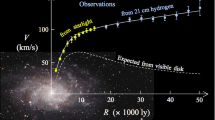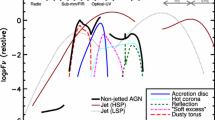Abstract
The standard \(\varLambda \hbox {CDM}\) model can be mimicked at the background and perturbative levels (linear and non-linear) by a class of gravitationally induced particle production cosmology dubbed CCDM cosmology. However, the radiation component in the CCDM model follows a slightly different temperature–redshift T(z)-law which depends on an extra parameter, \(\nu _r\), describing the subdominant photon production rate. Here we perform a statistical analysis based on a compilation of 36 recent measurements of T(z) at low and intermediate redshifts. The likelihood of the production rate in CCDM cosmologies is constrained by \(\nu _r = 0.024^{+0.026}_{-0.024}\) (\(1\sigma \) confidence level), thereby showing that \(\varLambda \)CDM (\(\nu _r=0\)) is still compatible with the adopted data sample. Although being hardly differentiated in the dynamic sector (cosmic history and matter fluctuations), the so-called thermal sector (temperature law, abundances of thermal relics and CMB power spectrum) offers a clear possibility for crucial tests confronting \(\varLambda \)CDM and CCDM cosmologies.



Similar content being viewed by others
Change history
12 November 2020
The publication of this article unfortunately contained a mistake. Equation��2 was not correct, you can find the corrected equation below.
Notes
Another possible uninformative prior would be Jeffreys prior. However, this prior diverges for \(\nu _r\rightarrow 0\) and the number of available data is enough for the results to be weakly dependent on the choice of uninformative priors [69], so we use only flat prior.
References
Weinberg, S.: Rev. Mod. Phys. 61, 1 (1989)
Peebles, P.J.E., Ratra, B.: Rev. Mod. Phys. 75, 559 (2003)
Padmanabhan, T.: Phys. Rep. 380, 235 (2003)
Lima, J.A.S.: Braz. J. Phys. 36, 1109 (2004). arXiv:astro-ph/0402109
Caldwell, R.R., Kamionkowski, M.: Ann. Rev. Nucl. Part. Sci. 59, 397 (2009). arXiv:0903.0866 [astro-ph.CO]
Sotiriou, T.P., Faraoni, V.: Rev. Mod. Phys. 82, 451 (2010). arXiv:0805.1726
Nojiri, S., Odintsov, S.D.: Phys. Rep. 505, 59 (2011). arXiv:1011.0544 [gr-qc]
de Martino, I., De Laurentis, M., Capozziello, S.: Universe 1(2), 123 (2015). arXiv:1507.06123 [gr-qc]
Nojiri, S., Odintsov, S.D., Oikonomou, V.K.: Phys. Rep. 692, 1 (2017). arXiv:1705.11098 [gr-qc]
Nojiri, S., Odintsov, S.D.: eConf C 0602061, 06 (2006)
Nojiri, S., Odintsov, S.D.: Int. J. Geom. Methods Mod. Phys. 4, 115 (2007). arXiv:hep-th/0601213
Capozziello, S., De Laurentis, M.: Phys. Rep. 509, 167 (2011). arXiv:1108.6266 [gr-qc]
Ratra, B., Peebles, P.J.E.: Phys. Rev. D 37, 3406 (1988)
Steinhardt, P.J.: Philos. Trans. R. Soc. Lond. A 361, 2497 (2003)
Carvalho, F.C., Alcaniz, J.S., Lima, J.A.S., Silva, R.: Phys. Rev. Lett. 97, 081301 (2006). arXiv:astro-ph/0608439
Demianski, M., Piedipalumbo, E., Rubano, C., Tortora, C.: Astron. Astrophys. 431, 27 (2005). arXiv:astro-ph/0410445
Basilakos, S., Plionis, M., Lima, J.A.S.: Phys. Rev. D 82, 083517 (2010). arXiv:1006.3418
Lima, J.A.S., Basilakos, S., Solà, J.: Mon. Not. R. Astron. Soc. 431, 923 (2013). arXiv:1209.2802
Perico, E.L.D., Lima, J.A.S., Basilakos, S., Solà, J.: Phys. Rev. D 88, 2063531 (2013). arXiv:1306.0591
Lima, J. A. S., Basilakos, S., Solà, J.: Gen. Relativ. Gravit. 47, 40 (2015). arXiv:1412.5196
Lima, J.A.S., Basilakos , S., Solà, J.: Eur. Phys. J. C 76 228 (2016). arXiv:1509.00163
de Martino, I.: Symmetry 10, 372 (2018). arXiv:1809.00550 [astro-ph.CO]
Wang, B., Abdalla, E., Atrio-Barandela, F., Pavon, D.: Rep. Prog. Phys. 79(9), 096901 (2016). arXiv:1603.08299 [astro-ph.CO]
Capozziello, S., Francaviglia, M., Mercadante, S.: Found. Phys. 39, 1161 (2009). arXiv:0805.3642 [gr-qc]
Nunes, R.C., Pan, S., Saridakis, E.N.: Phys. Rev. D 94(2), 023508 (2016). arXiv:1605.01712 [astro-ph.CO]
Jamil, M., Saridakis, E.N., Setare, M.R.: Phys. Rev. D 81, 023007 (2010). arXiv:0910.0822 [hep-th]
Chen, X.M., Gong, Y.G., Saridakis, E.N.: JCAP 0904, 001 (2009). arXiv:0812.1117 [gr-qc]
Faraoni, V., Dent, J.B., Saridakis, E.N.: Phys. Rev. D 90(6), 063510 (2014). arXiv:1405.7288 [gr-qc]
Lima, J.A.S., Jesus, J.F., Oliveira, F.A.: J. Cosmol. Astropart. Phys. 011, 027 (2010). arXiv:0911.5727
Lima, J.A.S., Basilakos, S., Costa, F.E.M.: Phys. Rev. D 86, 103534 (2012). arXiv:1205.0868
Jesus, J.F., Oliveira, F.A., Basilakos, S., Lima, J.A.S.: Phys. Rev. D 84, 063511 (2011). arXiv:1105.1027
Mimoso, J.P., Pavón, D.: Phys. Rev. D 87, 047302 (2013). arXiv:1302.1972
Komatsu, N., Kimura, S.: Phys. Rev. D 89, 123501 (2014). arXiv:1402.3755
Jesus, J.F., Pereira, S.H.: JCAP 07, 040 (2014). arXiv:1403.3679
Chakraborty, S., Pan, S., Saha, S.: Phys. Lett. B 738, 424 (2014)
Ramos, R.O., dos Santos, M.V., Waga, I.: Phys. Rev. D 89, 083524 (2014). arXiv:1404.2604
dos Santos, M.V., Waga, I., Ramos, R.O.: Phys. Rev. D 90, 127301 (2014)
Lima, J.A.S., Santos, R.C., Cunha, J.V.: J. Cosmol. Astropart. Phys. 03, 027 (2016). arXiv:1508.07263
Fixsen, D.J.: Astrophys. J. 707, 916 (2009). arXiv:0911.1955 [astro-ph.CO]
Aghanim, N. et al. [Planck Collaboration]. arXiv:1807.06209 [astro-ph.CO]
Lima, J.A.S.: Phys. Rev. D 54, 2571 (1996). arXiv:gr-qc/9605055
Lima, J.A.S.: Gen. Relativ. Gravit. 29, 805 (1997). arXiv:gr-qc/9605056
Lima, J.A.S., Abramo, L.R.W.: Phys. Lett. A 257, 123 (1999). arXiv:gr-qc/9606067
Lima, J.A.S., Silva, A.I., Viegas, S.M.: MNRAS 312, 747 (2000)
Komatsu, N., Kimura, S.: Phys. Rev. D 92, 043507 (2015). arXiv:1503.05895
de Martino, I., Atrio-Barandela, F., da Silva, A., Ebeling, H., Kashlinsky, A., Kocevski, D., Martins, C.J.A.P.: Astrophys. J. 757, 144 (2012). arXiv:1203.1825 [astro-ph]
de Martino, I., Gnova-Santos, R., Atrio-Barandela, F., Ebeling, H., Kashlinsky, A., Kocevski , D., Martins, Astrophys. C.J.A.P.: J. 808(2), 128 (2015). arXiv:1502.06707 [astro-ph.CO]
de Martino, I., Martins, C.J.A.P., Ebeling, H., Kocevski, D: Phys. Rev. D 94(8), 083008 (2016). arXiv:1605.03053 [astro-ph.CO]
Avgoustidis, A., Gnova-Santos, R.T., Luzzi, G., Martins, C.J.A.P.: Phys. Rev. D 93(4), 043521 (2016). arXiv:1511.04335 [astro-ph.CO]
Luzzi, G., Shimon, M., Lamagna, L., Rephaeli, Y., De Petris, M., Conte, A., De Gregori, S., Battistelli, E.S.: Astrophys. J. 705, 1122 (2009)
Luzzi, G., Gnova-Santos, R.T., Martins, C.J.A.P., De Petris, M., Lamagna, L.: JCAP 1509(09), 011 (2015). arXiv:1502.07858 [astro-ph.CO]
Hurier, G., Aghanim, N., Douspis, M., Pointecouteau, E.: Astron. Astrophys. 561, A143 (2014)
Saro, A. et al. [SPT Collaboration].: Mon. Not. R. Astron. Soc. 440(3), 2610 (2014). arXiv:1312.2462 [astro-ph.CO]
Prigogine, I., et al.: Gen. Relativ. Gravit. 21, 767 (1989)
Lima, J.A.S., Calvão, M.O., Waga, I.: Cosmology, thermodynamics and matter creation. In: Frontier Physics, Essays in Honor of Jayme Tiomno. World Scientific, Singapore (1990). arXiv:0708.3397
Calvão, M.O., Lima, J.A.S., Waga, I.: Phys. Lett. A 162, 223 (1992)
Lima, J.A.S., Germano, A.S.M.: Phys. Lett. A 170, 373 (1992)
Lima, J.A.S., Baranov, I.: Phys. Rev. D 90, 043515 (2014). arXiv:1411.6589
de Groot, S.R., van Leeuwen, W.A.,van Weert, CG.: Relativistic Kinetic Theory. North-Holland Publishing Company, North-Holland (1980)
Luzzi, G., Shimon, M., Lamagna, L., Rephaeli, Y., De Petris, M., Conte, A., De Gregori, S., Battistelli, E.S.: Astrophys. J. 705, 1122 (2009)
Srianand, R., Noterdaeme, P., Ledoux, C., Petitjean, P.: Astron. Astrophys. 482, L39 (2008)
Noterdaeme, P., Petitjean, P., Srianand, R., Ledoux, C., López, S.: Astron. Astrophys. 526, L7 (2011)
Cui, J., Bechtold, J., Ge, J., Meyer, D.M.: Astrophys. J. 633, 649 (2005)
Ge, J., Bechtold, J., Black, J.H.: Astrophys. J. 474, 67 (1997)
Srianand, R., Petitjean, P., Ledoux, C.: Nature (London) 408, 931 (2000)
Hurier, G., Aghanim, N., Douspis, M., Pointecouteau, E.: Astron. Astrophys. 561, A143 (2014). arXiv:1311.4694 [astro-ph.CO]
Mather, J.C., Fixsen, D.J., Shafer, R.A., Mosier, C., Wilkinson, D.T.: Astrophys. J. 512, 511 (1999)
Hinshaw, G., et al.: WMAP Collaboration. Astrophys. J. Suppl. 180, 225 (2009). arXiv:0803.0732 [astro-ph]
Jaynes, E.T.: Probability Theory: The Logic of Science. Cambridge University Press, Cambridge (2003)
Riess, A.G., et al.: arXiv:1604.01424v1
Baranov, I., Lima, J.A.S.: Phys. Lett. B 751, 338 (2015). arXiv:1505.02743
Landau, L.D., Lifshitz, E.M.: Statistical Physics. Elsevier Science, New York (2013)
Bernstein, J.: Kinetic Theory in the Expanding Universe. Cambridge University Press, Cambridge (1988)
Acknowledgements
The authors are partially supported by CNPq, FAPESP and CAPES (LLAMA project, INCT-A and PROCAD2013 projects). JFJ acknowledges financial support from FAPESP, Process \(\hbox {n}^\mathrm {o}\) 2017/05859-0, Fundação de Amparo à Pesquisa do Estado de São Paulo (FAPESP).
Author information
Authors and Affiliations
Corresponding author
Additional information
Publisher's Note
Springer Nature remains neutral with regard to jurisdictional claims in published maps and institutional affiliations.
Appendix A: Kinetic Theory and Temperature Law
Appendix A: Kinetic Theory and Temperature Law
In this appendix, we use the extended Boltzmann equation for gravitationally particle production, proposed in previous works [58, 71], to get the temperature evolution of the relic radiation.
In a multi-fluid approach, each component has its own equation with its corresponding production rate. The extended Boltzmann equation describing this gravitational, non-collisional (each component evolves freely from the others), process is
where \(f_i\) and \(\varGamma _i\) are, respectively, the distribution function and the production rate for the i-th component.
For a relativistic quantum gas, the distribution function is [72]
where \(\varTheta \) is the relativistic chemical potential, \(\beta = 1/T\), where T is the temperature, and \(\epsilon =\pm 1\) counts for different quantum statistics.
In the case of a relativistic bosonic gas with creation rate \(\varGamma _r\) (CMB radiation), by inserting () into () we obtain (see also [58]):
which has the solution \({\dot{\varTheta }}=0\) and
where a is the scale factor and \(\varGamma _r\) stands for the radiation production rate. The above expression is the same as Eq. 15 which was deduced based on the thermodynamic approach. In the limit \(\frac{\varGamma _r}{3H}\ll 1\), Eqs. and are reduced to the usual ones (see equations (3.70) and (3.71) in) [73].
Rights and permissions
About this article
Cite this article
Baranov, I.P.R., Jesus, J.F. & Lima, J.A.S. Testing creation cold dark matter cosmology with the radiation temperature–redshift relation. Gen Relativ Gravit 51, 33 (2019). https://doi.org/10.1007/s10714-019-2516-3
Received:
Accepted:
Published:
DOI: https://doi.org/10.1007/s10714-019-2516-3




